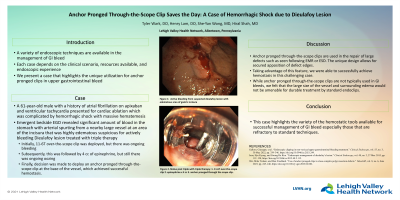Tuesday Poster Session
Category: GI Bleeding
P4198 - Anchor Pronged Through-the-Scope Clip Saves the Day: A Case of Hemorrhagic Shock due to Dieulafoy Lesion
Tuesday, October 29, 2024
10:30 AM - 4:00 PM ET
Location: Exhibit Hall E

Has Audio
- TW
Tyler Wark, DO
Lehigh Valley Health Network
Macungie, PA
Presenting Author(s)
Tyler Wark, DO1, Henry Lam, DO2, She-Yan Wong, MD2, Hiral Shah, MD3
1Lehigh Valley Health Network, Macungie, PA; 2Lehigh Valley Health Network, Allentown, PA; 3Lvhn, Center Valley, PA
Introduction: A variety of endoscopic techniques are available in the management of GI bleed. The specific tools employed in each case depends on the clinical scenario, resources available, and endoscopic experience. We present an interesting case in which a difficult to treat Dieulafoy lesion was managed with a unique cocktail of triple therapy including over-the-scope clip, epinephrine, and finally anchor pronged through-the-scope clip.
Case Description/Methods: A 61-year-old male with a history of atrial fibrillation on apixaban and ventricular tachycardia presented for cardiac ablation after recent admission for recurrent VT. Unfortunately, the procedure was complicated by massive hematemesis with an estimated blood loss of 800 cc. The patient was transferred to the ICU for hemorrhagic shock. Labs were most significant for anemia, hemoglobin 10.4 g/dL (baseline 13-14 g/dL). No reversal agent was needed as he had not taken anticoagulation for several days in anticipation of his cardiac procedure. Emergent bedside EGD revealed significant fresh gastric blood with arterial spurting from a large vessel along the incisura that was highly edematous. The clinical picture was consistent with an actively bleeding Dieulafoy lesion. Endotherapy with an 11-6T over-the-scope clip was deployed. Despite this, ongoing bleed was appreciated. Thus, 4 cc of epinephrine was administered for hemostasis; however, there was still a mild amount of oozing. Finally, the decision was made to deploy an anchor pronged through-the-scope clip at the base of the vessel, which finally achieved successful endoscopic hemostasis. The patient was monitored with no recurrence of bleeding with eventual resumption of anticoagulation.
Discussion: Anchor pronged through-the-scope clips are used in the repair of large defects such as seen following EMR or ESD. The unique design allows for secured apposition of defect edges. Taking advantage of this feature, we were able to successfully achieve hemostasis in this challenging case. While anchor pronged through-the-scope clips are not typically used in GI bleeds, we felt that the large size of the vessel and surrounding edema would not be amenable for durable treatment by standard endoclips. This case highlights the variety of the hemostatic tools available for successfully management of GI bleed; especially those that are refractory to standard techniques.
Disclosures:
Tyler Wark, DO1, Henry Lam, DO2, She-Yan Wong, MD2, Hiral Shah, MD3. P4198 - Anchor Pronged Through-the-Scope Clip Saves the Day: A Case of Hemorrhagic Shock due to Dieulafoy Lesion, ACG 2024 Annual Scientific Meeting Abstracts. Philadelphia, PA: American College of Gastroenterology.
1Lehigh Valley Health Network, Macungie, PA; 2Lehigh Valley Health Network, Allentown, PA; 3Lvhn, Center Valley, PA
Introduction: A variety of endoscopic techniques are available in the management of GI bleed. The specific tools employed in each case depends on the clinical scenario, resources available, and endoscopic experience. We present an interesting case in which a difficult to treat Dieulafoy lesion was managed with a unique cocktail of triple therapy including over-the-scope clip, epinephrine, and finally anchor pronged through-the-scope clip.
Case Description/Methods: A 61-year-old male with a history of atrial fibrillation on apixaban and ventricular tachycardia presented for cardiac ablation after recent admission for recurrent VT. Unfortunately, the procedure was complicated by massive hematemesis with an estimated blood loss of 800 cc. The patient was transferred to the ICU for hemorrhagic shock. Labs were most significant for anemia, hemoglobin 10.4 g/dL (baseline 13-14 g/dL). No reversal agent was needed as he had not taken anticoagulation for several days in anticipation of his cardiac procedure. Emergent bedside EGD revealed significant fresh gastric blood with arterial spurting from a large vessel along the incisura that was highly edematous. The clinical picture was consistent with an actively bleeding Dieulafoy lesion. Endotherapy with an 11-6T over-the-scope clip was deployed. Despite this, ongoing bleed was appreciated. Thus, 4 cc of epinephrine was administered for hemostasis; however, there was still a mild amount of oozing. Finally, the decision was made to deploy an anchor pronged through-the-scope clip at the base of the vessel, which finally achieved successful endoscopic hemostasis. The patient was monitored with no recurrence of bleeding with eventual resumption of anticoagulation.
Discussion: Anchor pronged through-the-scope clips are used in the repair of large defects such as seen following EMR or ESD. The unique design allows for secured apposition of defect edges. Taking advantage of this feature, we were able to successfully achieve hemostasis in this challenging case. While anchor pronged through-the-scope clips are not typically used in GI bleeds, we felt that the large size of the vessel and surrounding edema would not be amenable for durable treatment by standard endoclips. This case highlights the variety of the hemostatic tools available for successfully management of GI bleed; especially those that are refractory to standard techniques.
Disclosures:
Tyler Wark indicated no relevant financial relationships.
Henry Lam indicated no relevant financial relationships.
She-Yan Wong indicated no relevant financial relationships.
Hiral Shah: Abbvie – Speakers Bureau.
Tyler Wark, DO1, Henry Lam, DO2, She-Yan Wong, MD2, Hiral Shah, MD3. P4198 - Anchor Pronged Through-the-Scope Clip Saves the Day: A Case of Hemorrhagic Shock due to Dieulafoy Lesion, ACG 2024 Annual Scientific Meeting Abstracts. Philadelphia, PA: American College of Gastroenterology.
